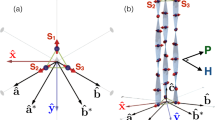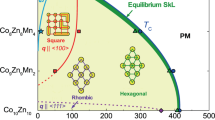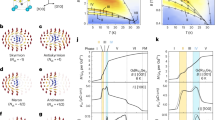Abstract
Magnetic materials can host skyrmions, which are topologically non-trivial spin textures. In chiral magnets with cubic lattice symmetry, all previously observed skyrmion phases require thermal fluctuations to become thermodynamically stable in bulk materials, and therefore exist only at relatively high temperature, close to the helimagnetic transition temperature. Other stabilization mechanisms require a lowering of the cubic crystal symmetry. Here, we report the identification of a second skyrmion phase in Cu2OSeO3 at low temperature and in the presence of an applied magnetic field. The new skyrmion phase is thermodynamically disconnected from the well-known, nearly isotropic, high-temperature phase, and exists, in contrast, when the external magnetic field is oriented along the 〈100〉 crystal axis only. Theoretical modelling provides evidence that the stabilization mechanism is given by well-known cubic anisotropy terms, and accounts for an additional observation of metastable helices tilted away from the applied field. The identification of two distinct skyrmion phases in the same material and the generic character of the underlying mechanism suggest a new avenue for the discovery, design and manipulation of topological spin textures.
This is a preview of subscription content, access via your institution
Access options
Access Nature and 54 other Nature Portfolio journals
Get Nature+, our best-value online-access subscription
$29.99 / 30 days
cancel any time
Subscribe to this journal
Receive 12 print issues and online access
$209.00 per year
only $17.42 per issue
Buy this article
- Purchase on Springer Link
- Instant access to full article PDF
Prices may be subject to local taxes which are calculated during checkout




Similar content being viewed by others
References
Skyrme, T. A unified field theory of mesons and baryons. Nucl. Phys. 31, 556–569 (1962).
Brown, G. E. & Rho, M. The Multifaceted Skyrmion (World Scientific, Singapore, 2010).
Volovik, G. The Universe in a Helium Droplet (Clarendon Press, Oxford, 2003).
Al Khawaja, U. & Stoof, H. Skyrmions in a ferromagnetic Bose–Einstein condensate. Nature 411, 918–920 (2001).
Mühlbauer, S. et al. Skyrmion lattice in a chiral magnet. Science 323, 915–919 (2009).
Münzer, W. et al. Skyrmion lattice in the doped semiconductor Fe1−xCoxSi. Phys. Rev. B 81, 041203(R) (2010).
Yu, X. Z. et al. Near room-temperature formation of a skyrmion crystal in thin-films of the helimagnet FeGe. Nat. Mater. 10, 106–109 (2011).
Seki, S., Yu, X. Z., Ishiwata, S. & Tokura, Y. Observation of skyrmions in a multiferroic material. Science 336, 198–201 (2012).
Nagaosa, N. & Tokura, Y. Topological properties and dynamics of magnetic skyrmions. Nat. Nanotech. 8, 899–911 (2013).
Landau, L. D. & Lifshitz, E. M. Course of Theoretical Physics Vol. 8 (Pergamon Press, Oxford, 1980).
Bogdanov, A. & Yablonskii, D. Thermodynamically stable “vortices” in magnetically ordered crystals. The mixed state of magnets. Zh. Eksp. Teo. Fiz. 95, 178–182 (1989).
Tokunaga, Y. et al. A new class of chiral materials hosting magnetic skyrmions beyond room temperature. Nat. Commun. 6, 7638 (2015).
Buhrandt, S. & Fritz, L. Skyrmion lattice phase in three-dimensional chiral magnets from Monte Carlo simulations. Phys. Rev. B 88, 195137 (2013).
Bauer, A. & Pfleiderer, C. in Generic Aspects of Skyrmion Lattices in Chiral Magnets in Topological Structures in Ferroic Materials (ed. Seidel, J.) 1–28 (Springer, Basel, 2016).
Kezsmarki, I. et al. Néel-type skyrmion lattice with confined orientation in the polar magnetic semiconductor GaV4S8. Nat. Mater. 14, 1116–1122 (2015).
Bordacs, S. et al. Equilibrium skyrmion lattice ground state in a polar easy-plane magnet. Sci. Rep. 7, 7584 (2017).
Yu, X. et al. Magnetic stripes and skyrmions with helicity reversals. Proc. Natl Acad. Sci. 109, 8856–8860 (2012).
Nayak, A. K. et al. Magnetic antiskyrmions above room temperature in tetragonal Heusler materials. Nature 548, 561–566 (2017).
Wilson, M. N., Butenko, A. B., Bogdanov, A. N. & Monchesky, T. L. Chiral skyrmions in cubic helimagnet films: The role of uniaxial anisotropy. Phys. Rev. B 89, 094411 (2014).
Kanazawa, N. et al. Critical phenomena of emergent magnetic monopoles in a chiral magnet. Nat. Commun. 7, 11622 (2016).
Chacon, A. et al. Uniaxial pressure dependence of magnetic order in MnSi. Phys. Rev. Lett. 115, 267202 (2015).
Okamura, Y., Kagawa, F., Seki, S. & Tokura, Y. Transition to and from the skyrmion lattice phase by electric fields in a magnetoelectric compound. Nat. Commun. 7, 12669 (2016).
Oike, H. et al. Interplay between topological and thermodynamic stability in a metastable magnetic skyrmion lattice. Nat. Phys. 12, 62–66 (2016).
Karube, K. et al. Robust metastable skyrmions and their triangular-square lattice structural transition in a high-temperature chiral magnet. Nat. Mater. 15, 1237–1242 (2016).
Grigoriev, S. V., Sukhanov, A. S. & Maleyev, S. V. From spiral to ferromagnetic structure in B20 compounds: Role of cubic anisotropy. Phys. Rev. B 91, 224429 (2015).
Belesi, M. et al. Magnetoelectric effects in single crystals of the cubic ferrimagnetic helimagnet Cu2OSeO3. Phys. Rev. B 85, 224413 (2012).
Qian, F. et al. Phase diagram and magnetic relaxation phenomena in Cu2OSeO3. Phys. Rev. B 94, 064418 (2016).
Qian, F. et al. New magnetic phase of the chiral skyrmion material Cu2OSeO3. Preprint at https://arXiv.org/1802.02070v2 (2018).
Milde, P. et al. Unwinding of a skyrmion lattice by magnetic monopoles. Science 340, 1076–1080 (2013).
Wild, J. et al. Entropy-limited topological protection of skyrmions. Sci. Adv. 3, e1701704 (2017).
Mühlbauer, S. et al. The new small-angle neutron scattering instrument SANS-1 at MLZ—characterization and first results. Nucl. Instr. Meth. Phys. Res. A 832, 297–305 (2016).
Acknowledgements
We wish to thank F. Haslbeck, S. Mayr, M. Meven and the team at FRM II for helpful discussions and support. A.C., M.H. and W.S. acknowledge financial support through the TUM Graduate School. L.H. and A.R. acknowledge financial support through DFG CRC1238 (project C02). M.G. acknowledges financial support from DFG CRC 1143 and DFG grant 1072/5. A.B., M.H., W.S. and C.P. acknowledge support through DFG TRR80 (projects E1, F2 and F7) as well as ERC-AdG (291079 TOPFIT).
Author information
Authors and Affiliations
Contributions
A.C., M.H., A.B., W.S. and S.M. performed the experimental work; A.C. analysed the data; C.P. supervised the experimental work; H.B. grew the single crystals; L.H., M.G. and A.R. developed the theoretical analysis; A.C. and C.P. proposed this study and wrote the manuscript; all authors discussed the data and commented on the manuscript; correspondence may be addressed to A.C. and C.P.
Corresponding authors
Additional information
Publisher’s note: Springer Nature remains neutral with regard to jurisdictional claims in published maps and institutional affiliations.
Supplementary information
Supporting online material
Supplementary figures S1 to S23
Rights and permissions
About this article
Cite this article
Chacon, A., Heinen, L., Halder, M. et al. Observation of two independent skyrmion phases in a chiral magnetic material. Nature Phys 14, 936–941 (2018). https://doi.org/10.1038/s41567-018-0184-y
Received:
Accepted:
Published:
Issue Date:
DOI: https://doi.org/10.1038/s41567-018-0184-y
This article is cited by
-
Task-adaptive physical reservoir computing
Nature Materials (2024)
-
Progress on elliptical magnetic skyrmions
Rare Metals (2023)
-
Squeezing the periodicity of Néel-type magnetic modulations by enhanced Dzyaloshinskii-Moriya interaction of 4d electrons
npj Quantum Materials (2022)
-
Origin of metamagnetism in skyrmion host Cu\(_2\)OSeO\(_3\)
Scientific Reports (2022)
-
History-dependent domain and skyrmion formation in 2D van der Waals magnet Fe3GeTe2
Nature Communications (2022)



